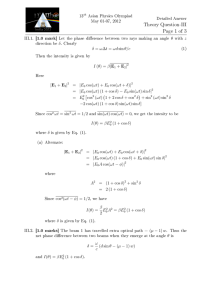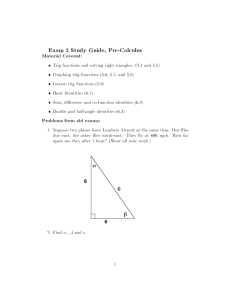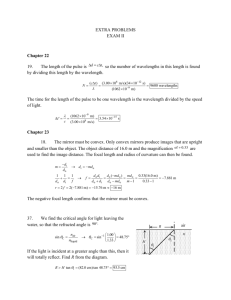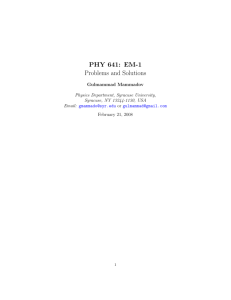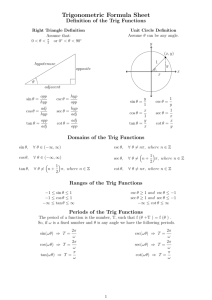Some trig identities for Math 1B Sep 2, 2009
advertisement
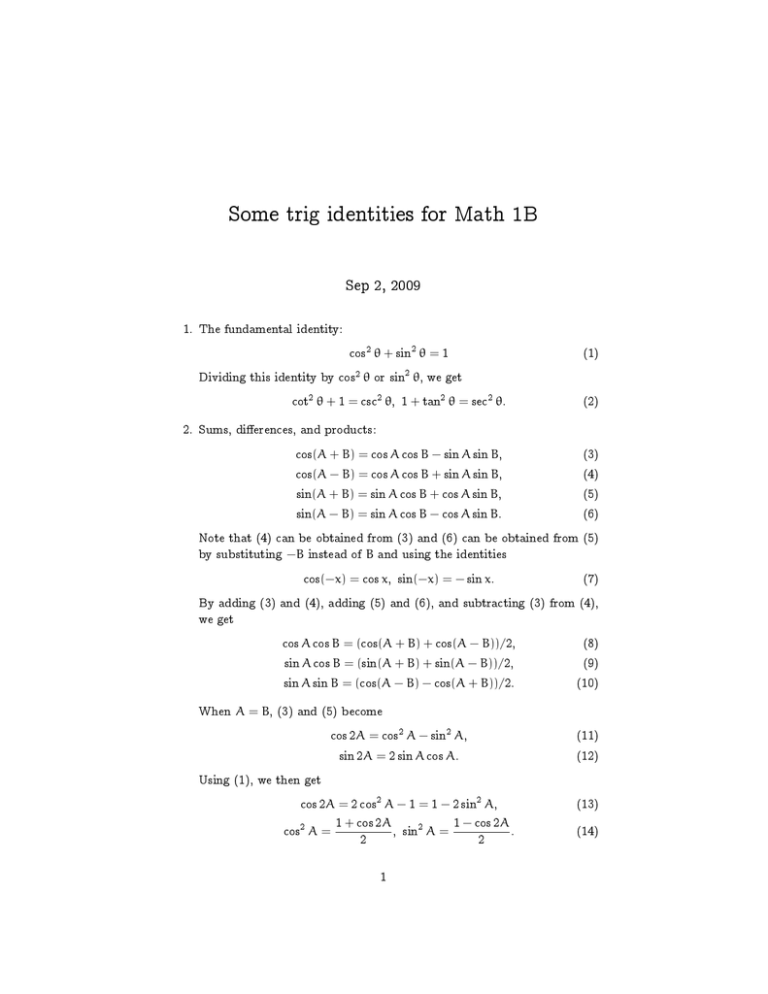
Some trig identities for Math 1B
Sep 2, 2009
1. The fundamental identity:
cos2 θ + sin2 θ = 1
(1)
2
Dividing this identity by cos2 θ or sin θ, we get
cot2 θ + 1 = csc2 θ, 1 + tan2 θ = sec2 θ.
(2)
2. Sums, dierences, and products:
cos(A + B) = cos A cos B − sin A sin B,
cos(A − B) = cos A cos B + sin A sin B,
sin(A + B) = sin A cos B + cos A sin B,
sin(A − B) = sin A cos B − cos A sin B.
(3)
(4)
(5)
(6)
Note that (4) can be obtained from (3) and (6) can be obtained from (5)
by substituting −B instead of B and using the identities
cos(−x) = cos x, sin(−x) = − sin x.
(7)
By adding (3) and (4), adding (5) and (6), and subtracting (3) from (4),
we get
cos A cos B = (cos(A + B) + cos(A − B))/2,
sin A cos B = (sin(A + B) + sin(A − B))/2,
sin A sin B = (cos(A − B) − cos(A + B))/2.
(8)
(9)
(10)
When A = B, (3) and (5) become
cos 2A = cos2 A − sin2 A,
sin 2A = 2 sin A cos A.
(11)
(12)
cos 2A = 2 cos2 A − 1 = 1 − 2 sin2 A,
1 − cos 2A
1 + cos 2A
cos2 A =
, sin2 A =
.
2
2
(13)
Using (1), we then get
1
(14)
3. Dierentiation:
d(cos x) = − sin x dx, d(sin x) = cos x dx,
Z
2
2
(15)
(16)
d(tan x) = sec x dx, d(cot x) = − csc x dx,
Z
sec x dx = ln | sec x + tan x| + C, csc x dx = ln | csc x − cot x| + C. (17)
4. Integrating trigonometric expressions:
If our expression contains the factor sin x dx and the remaining part is
a function of cos x, sin2 x, tan2 x, and cot2 x, then do the substitution
u = cos x and then use the identities (1){(2) to express everything
as a function of u. Example:
Z
Z
ln(cos x) sin3 x dx = ln(cos x) sin2 x(sin x dx)
Z
Z
= (1 − cos2 x) ln(cos x)d(− cos x) = − (1 − u2 ) ln u du.
Similarly, if our expression contains the factor cos x dx and the remaining part is a function of sin x, cos2 x, tan2 x, and cot2 x, then do
the substitution u = sin x.
If our expression contains only squares of trigonometric functions
(cos2 x, sin2 x, etc.) and the product cos x sin x, then use the identities
(14) and (12) to get an expression in terms of cos 2x and sin 2x and
then do the substitution u = 2x. Example:
Z
Z
1 1 + cos 2x
cos2 x
dx =
dx
1 + 2 sin x cosZx
2 1 + sin 2x
1 1 + cos u
du.
=
4 1 + sin u
If our expression contains the factor sec2 x dx and the remaining part
is a function of tan x, cot x, cos2 x, and sin2 x, then do the substitution u = tan x and use the identities (2) to express everything as a
function of u. Example:
Z
Z
4
sec x dx = sec2 x(sec2 x dx)
Z
Z
= (1 + tan2 x) d(tan x) = 1 + u2 du.
Similarly, one can use the substitution u = cot x in case we have the
factor csc2 x dx.
2
